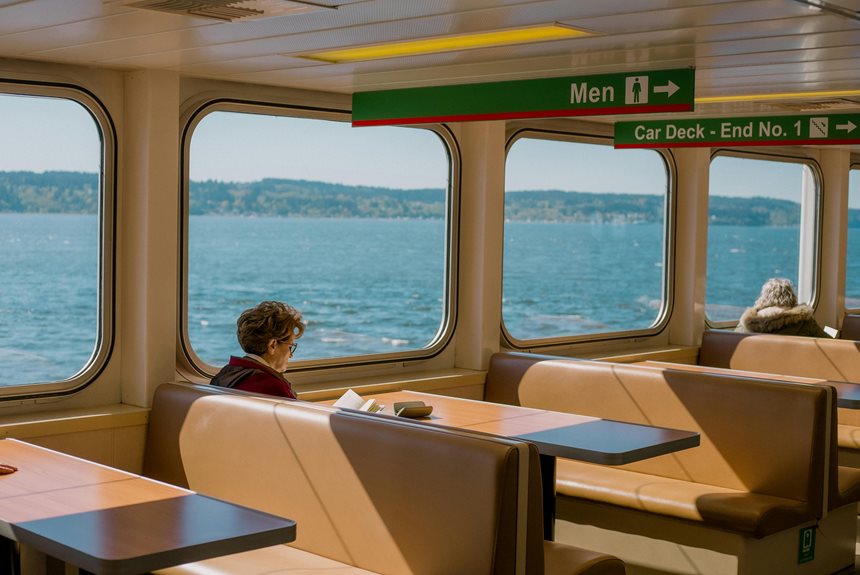You’ll find three main ferry services connecting Kagoshima to Yakushima: the high-speed Tane Yaku Jetfoil (1h 50m, ¥12,000), mid-speed Ferry Yakushima 2 (4h, ¥6,100), and overnight Ferry Hibiscus (¥3,900). The Jetfoil offers five daily routes to Miyanoura or Anbo ports, while Yakushima 2 departs once daily at 08:30. You can book Jetfoil tickets up to two months ahead, but Ferry Yakushima 2 requires cash payment on departure day. Let’s explore your ferry options in detail.
Ferry Routes Overview
When traveling from Kagoshima to Yakushima, you’ll find three main ferry services operating regular routes. The Tane Yaku Jetfoil offers high-speed hydrofoil services, while Ferry Yakushima 2 provides mid-speed options, and Ferry Hibiscus runs slower, overnight journeys.
You can depart from several locations within Kagoshima, including the High-speed boat Terminal, Ferry Terminal, and Taniyama Port. During the monsoon season, which typically runs from early June to mid-July, ferry schedules may be affected.
Each service offers distinct advantages: the Jetfoil gets you there fastest at ¥12,000 one-way, Ferry Yakushima 2 provides a balanced option at ¥6,100, and Ferry Hibiscus gives you the most economical choice at ¥3,900.
For the best experience, book your tickets in advance, especially during peak travel periods. Weather conditions may affect travel times, so plan accordingly.
Journey Times and Schedules
The journey time from Kagoshima to Yakushima varies based on your chosen ferry service.
You’ll reach your destination in just 1 hour 50 minutes on the Tane Yaku Hydrofoil (Toppy or Rocket), while the Yaku 2 Car Ferry takes 4 hours but offers more amenities.
You can catch the earliest departure at 07:30 from Kagoshima, with multiple daily options until the last hydrofoil at 14:45.
The Tane Yaku Hydrofoil operates five daily routes, arriving at either Miyanoura or Anbo ports.
If you’re taking the Yaku 2 Car Ferry, you’ll depart Kagoshima at 08:30 and arrive at 12:30.
For your return journey, the car ferry leaves Yakushima at 13:30, reaching Kagoshima at 17:40.
A return ticket costs 9200 yen for the standard fare, with discounted rates available during off-season periods.
Remember that weather conditions may affect travel times and comfort.
Booking Your Tickets
Making reservations for your Yakushima ferry journey is straightforward through several booking methods.
You can book the Toppy and Rocket hydrofoils up to two months ahead online, while the Yakushima 2 ferry requires cash payment on your departure day.
For the Toppy and Rocket services, you’ll have flexibility to change your standard tickets multiple times before departure, and return tickets remain valid for seven days.
The overnight Hibiscus ferry departs from Taniyama Port daily, offering a budget-friendly alternative for travelers.
If you’re booking accommodation through YES worth over 40,000 yen, you’ll get access to their jet foil reservation service, though you’ll still need to pay for the tickets.
Book well in advance during peak seasons like Golden Week, Obon, weekends, and holidays to secure your spot.
Remember to check weather updates regularly, as services may face cancellations during adverse conditions.
Cost and Payment Options
Travelers planning their journey to Yakushima have several ferry options at different price points, with the Toppy Jetfoil being the most expensive at ¥12,200 for a single adult ticket and the Hibiscus slow ferry offering the most economical choice at ¥3,700 one-way.
You can pay with cash at any port, while credit cards are accepted only at the Kagoshima side and for Toppy ferry tickets. Multiple daily journeys are available on the Toppy Jetfoil, with 5-7 return trips between 7 am and 4 pm.
If you’re traveling with children aged 6-11, you’ll get discounted rates on all ferries, and kids under 5 travel free without allocated seats.
For added convenience, you can book through YES Yakushima’s ferry reservation service at no extra cost.
Remember to carry Japanese yen, as foreign currencies aren’t accepted at the ports, and credit card transactions may incur international exchange rates.
Onboard Facilities and Services
Each ferry service to Yakushima offers distinct onboard amenities, with comfort levels varying based on vessel type and journey duration.
You’ll find the Ferry Yakushima 2 provides the most extensive facilities, including kids’ rooms, a shop for snacks and souvenirs, a noodle bar, and even slot machines for entertainment.
If you’re taking the high-speed Toppy & Rocket, expect basic seating designed for quick trips, with minimal amenities due to the shorter journey time. Service availability may be affected during summer typhoon season, leading to potential schedule changes or cancellations.
For overnight travelers, the Ferry Hibiscus offers carpeted sleeping platforms with blankets and pillows, though facilities are basic with vending machines for instant noodles and drinks.
Consider your priorities when choosing: Ferry Yakushima 2 for comfort and entertainment, Toppy & Rocket for speed and efficiency, or Ferry Hibiscus for basic overnight accommodation.
Weather Considerations and Cancellations
While planning your ferry journey to Yakushima, you’ll need to account for potential weather disruptions that can affect services throughout the year.
Typhoons pose the greatest risk from July to October, while thick fog and strong winds can cause cancellations in any season.
To protect your travel plans, book your tickets in advance and consider travel insurance that covers weather-related disruptions.
Monitor weather forecasts closely before your departure date and stay in contact with ferry operators for real-time updates.
It’s wise to build flexibility into your schedule, as ferries are more likely to be cancelled than flights during adverse conditions. Local residents often display exceptional hospitality when travelers face weather-related delays.
Choose reliable operators and maintain a backup plan for accommodation in case you get stranded.
During peak typhoon season, consider scheduling your trip for another time.
Port Information and Locations
Three main ports serve the Kagoshima-Yakushima ferry route, with the South Pier (Minami Futo) functioning as the primary departure point in Kagoshima City.
You’ll find the Express Boat Terminal, marked by its distinctive green triangular roof, where you can board the Toppy and Rocket jetfoils.
For overnight travel, head to Taniyama Port south of the city to catch the Hibiscus freight ferry.
On Yakushima, your ferry will dock at either Miyanoura Port or Anbo Port. The journey takes 2.5 to 4 hours depending on your chosen vessel.
You can easily reach the Kagoshima terminals by taking the city tram from Kagoshima Chuo Station to Suizokukanguchi, or walk 12 minutes from JR Kagoshima Station.
The terminals offer parking facilities, and you’ll find the ticket counters operating from 7:00-19:00, though the main terminal stays open 24 hours.
Car and Freight Transportation
For travelers planning to bring their vehicles to Yakushima, the Yaku 2 and Hibiscus ferries offer reliable car transport services.
The Yaku 2 completes the journey in 4 hours, departing Kagoshima at 8:30 AM and returning at 1:30 PM. You’ll pay around 40,000 yen for a round-trip car transport. The standard one-way passenger fare is 6,000 yen on this route.
The Hibiscus freight ferry provides an overnight alternative, departing Taniyama Port at 6:00 PM and arriving at Miyanoura Port at 7:00 AM the next day.
While car fares vary, passenger return tickets cost 7,800 yen. Both ferries can accommodate freight shipments alongside vehicles.
To secure your spot, especially during peak seasons, you’ll need to make reservations.
Contact the Yaku 2 center at 099-226-0731 or Hibiscus at 099-261-7000.
Seasonal Travel Tips
Timing your ferry journey to Yakushima requires careful consideration of seasonal patterns.
During high season, which includes weekends, Golden Week, and Obon, you’ll need to pre-book your tickets well in advance to secure your spot. Don’t wait until the last minute, as demand surges greatly during these periods. Check local tide height variations when planning your crossing for the smoothest possible journey.
To maximize your travel budget, consider booking outside peak periods when prices are lower.
If you must travel during high season, you’ll benefit from the increased ferry frequency, particularly on the Toppy/Rocket hydrofoil with its eight daily round trips.
While scheduling options expand during peak times, so does competition for seats. Make sure you’re ready to book as soon as reservations open, and remember that return tickets must be used within seven days of your outbound journey.




Konnichiwa! (Hello!) I'm Pat Tokuyama, a Japanese tofu cookbook author, who travels for music, food, and adventure. If you like Japanese tea, checkout some of the newestorganic japanese tea, matcha bowls and noren and more!
** Curious about the Plant Based Japanese Cooking Club? ** Learn more here!